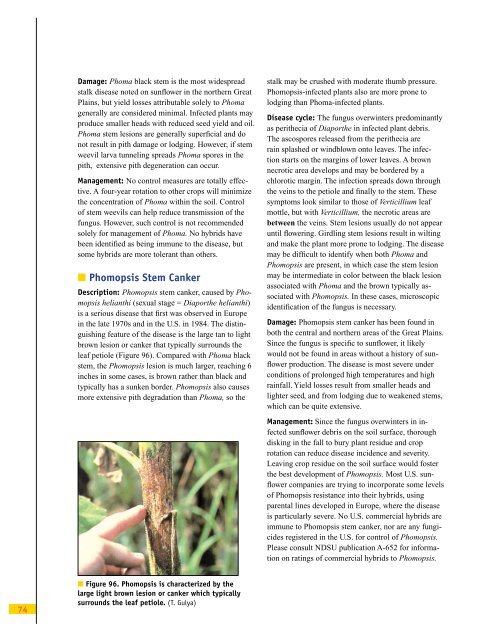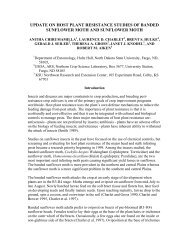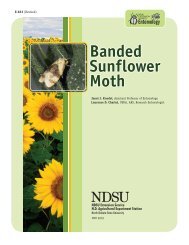Sunflower Production - NDSU Agriculture - North Dakota State ...
Sunflower Production - NDSU Agriculture - North Dakota State ...
Sunflower Production - NDSU Agriculture - North Dakota State ...
You also want an ePaper? Increase the reach of your titles
YUMPU automatically turns print PDFs into web optimized ePapers that Google loves.
Damage: Phoma black stem is the most widespreadstalk disease noted on sunflower in the northern GreatPlains, but yield losses attributable solely to Phomagenerally are considered minimal. Infected plants mayproduce smaller heads with reduced seed yield and oil.Phoma stem lesions are generally superficial and donot result in pith damage or lodging. However, if stemweevil larva tunneling spreads Phoma spores in thepith, extensive pith degeneration can occur.Management: No control measures are totally effective.A four-year rotation to other crops will minimizethe concentration of Phoma within the soil. Controlof stem weevils can help reduce transmission of thefungus. However, such control is not recommendedsolely for management of Phoma. No hybrids havebeen identified as being immune to the disease, butsome hybrids are more tolerant than others.■ Phomopsis Stem CankerDescription: Phomopsis stem canker, caused by Phomopsishelianthi (sexual stage = Diaporthe helianthi)is a serious disease that first was observed in Europein the late 1970s and in the U.S. in 1984. The distinguishingfeature of the disease is the large tan to lightbrown lesion or canker that typically surrounds theleaf petiole (Figure 96). Compared with Phoma blackstem, the Phomopsis lesion is much larger, reaching 6inches in some cases, is brown rather than black andtypically has a sunken border. Phomopsis also causesmore extensive pith degradation than Phoma, so thestalk may be crushed with moderate thumb pressure.Phomopsis-infected plants also are more prone tolodging than Phoma-infected plants.Disease cycle: The fungus overwinters predominantlyas perithecia of Diaporthe in infected plant debris.The ascospores released from the perithecia arerain splashed or windblown onto leaves. The infectionstarts on the margins of lower leaves. A brownnecrotic area develops and may be bordered by achlorotic margin. The infection spreads down throughthe veins to the petiole and finally to the stem. Thesesymptoms look similar to those of Verticillium leafmottle, but with Verticillium, the necrotic areas arebetween the veins. Stem lesions usually do not appearuntil flowering. Girdling stem lesions result in wiltingand make the plant more prone to lodging. The diseasemay be difficult to identify when both Phoma andPhomopsis are present, in which case the stem lesionmay be intermediate in color between the black lesionassociated with Phoma and the brown typically associatedwith Phomopsis. In these cases, microscopicidentification of the fungus is necessary.Damage: Phomopsis stem canker has been found inboth the central and northern areas of the Great Plains.Since the fungus is specific to sunflower, it likelywould not be found in areas without a history of sunflowerproduction. The disease is most severe underconditions of prolonged high temperatures and highrainfall. Yield losses result from smaller heads andlighter seed, and from lodging due to weakened stems,which can be quite extensive.Management: Since the fungus overwinters in infectedsunflower debris on the soil surface, thoroughdisking in the fall to bury plant residue and croprotation can reduce disease incidence and severity.Leaving crop residue on the soil surface would fosterthe best development of Phomopsis. Most U.S. sunflowercompanies are trying to incorporate some levelsof Phomopsis resistance into their hybrids, usingparental lines developed in Europe, where the diseaseis particularly severe. No U.S. commercial hybrids areimmune to Phomopsis stem canker, nor are any fungicidesregistered in the U.S. for control of Phomopsis.Please consult <strong>NDSU</strong> publication A-652 for informationon ratings of commercial hybrids to Phomopsis.74■ Figure 96. Phomopsis is characterized by thelarge light brown lesion or canker which typicallysurrounds the leaf petiole. (T. Gulya)










